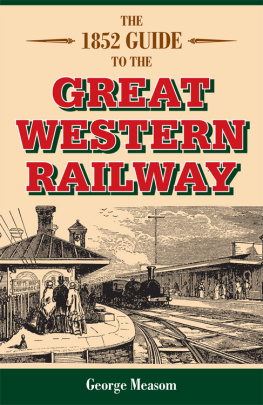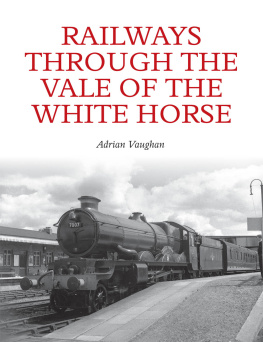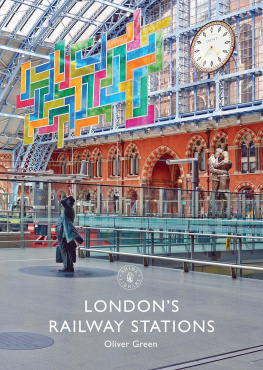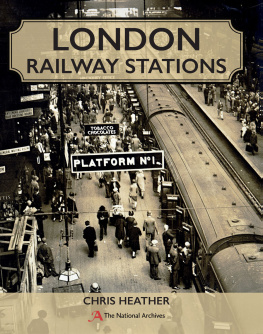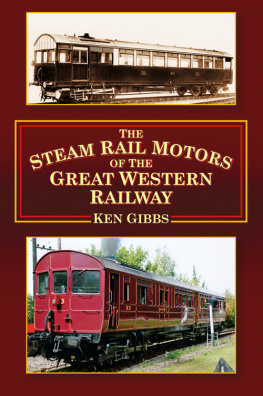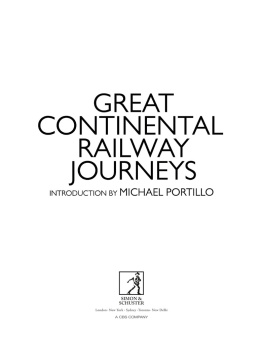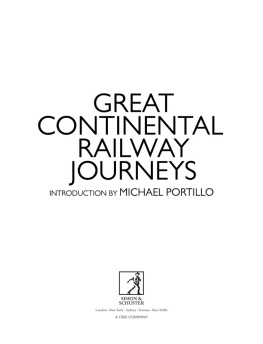BY GEORGE MEASOM.
Contents.
The Illustrated Guide
GREAT WESTERN RAILWAY.
__________________
HISTORY OF THE RAILWAYPOPULATION OF THE DISTRICT THROUGH WHICH IT PASSESLOCOMOTIVE ENGINESSUPERIOR SPEED OF THE BROAD GAUGEAMOUNT OF TRAFFICPADDINGTON TERMINUS AND HOTEL.

T HE GREAT WESTERN RAILWAY was suggested, in the first instance, by the anxious desire of the merchants and men of influence in Bristol, as well as of the colliery-owners and clothing-manufacturers of Gloucestershire and Somersetshire, in order to establish for themselves the same rapid and effective communication with the Metropolis which had already been secured under Act of Parliament for Liverpool, Manchester, and Birmingham. In practice, however, it has proved, that neither to the shipping-trade of Bristol, nor to its neighbouring coal-fields, nor to the manufacturing industry of Gloucester, Somerset, and Wilts, does this great Line owe its present success and prosperity; for the importance of Bristol, as a commercial port, as far at least as regards a portion of its exports, has yearly diminished, owing to the constantly rising importance of Liverpool and Glasgow; the collieries of West Somerset and South Gloucestershire are neither now nor ever can be valuable, except to the neighbourhood in which they lie; and the clothiers of the West have been all but superseded in the markets by the great manufacturers of the West-Riding of Yorkshire. Commerce, indeed, and manufacturing industry and inland-trade, have undoubtedly furnished staple materials for the vast business of the London and Birmingham Railway, and its continuations; but the Great Western owes its chief success, and the success, also, of its adjunct and dependent lines, to a distinct section of the population altogether, in fact, to that portion of the people of England who possess the property of the soil, are supported by its produce, or derive their subsistence from supplying the wants of the landowners, their tenants, and their labourers. This, at least, has been the case down to the present time; though it seems more than probable, that the early opening of the Branch-line through Oxford and Banbury to Birmingham, in order to compete with the London and North Western, will introduce the Great Western to a new source of traffic and revenue among the manufacturing interest, of which the Birmingham and Manchester Lines have hitherto enjoyed so long a monopoly.
The success of the Great Western Railway, notwithstanding its grand scale, and all the vastly additional expense of its construction and maintenance, is positive and permanent; nor need we wonder at it, when we recollect, that this great Trunk-line itself (exclusive of the Bristol and Exeter, the South Devon, and the South Wales Branch-lines) forms a channel of communication with such places as the following :
| Population. |
| BRISTOL and CLIFTON (1851) | 143,700 |
| BATH | 69,840 |
| CHELTENHAM | 40,246 |
| Stroud | 37,380 |
| Gloucester | 32,060 |
| Devizes | 22,240 |
| Reading | 22,170 |
| WINDSOR AND ETON | 40,890 |
| Banbury | 29,790 |
| Chippenham | 21,420 |
| Cirencester | 21,330 |
| Newbury | 20,820 |
| Hungerford | 20,410 |
| OXFORD | 20,170 |
Let us add to these about thirty other towns, having more than 10,000 inhabitants; and we shall have a merely civic population of about twelve hundred thousand; to which, if we add again about 900,000 for the rural population of South Bucks, Berks, West Oxfordshire, North Wiltshire, Somersetshire, and Gloucestershire, we shall have a grand total of about two millions of persons, living in the provinces, who receive benefit, either directly or indirectly, from the establishment and maintenance of the Great Western. To these, again, we must add that vast but undefinable number of persons, who use this Line as the medium of their pleasures, as a rapid means of access to some pleasant spot, chosen for a holidays trip,to some meeting of hounds,to some secluded stream loved by anglers, &c. &c.; and, once more, we must not forget to take into our calculation the numbers of the inhabitants of London constantly using the Line for short journeys into the suburbs, and likewise the great influx of travellers from many and various quarters, who, having travelled long distances on the narrow gauge of other Lines, are glad to get quickly home by the broad gauge of the Great Western Company. On the whole, therefore, we are not far from the mark, when we say, that a population of nearly three millions of people avail themselves, directly or indirectly, of the immense advantages offered by the Great Western Railway, for conveying not only various classes of passengers, but every description of luggage.
The first idea of this most important Line was published to the world in the local reports of a great meeting held at Bristol, July 30, 1833; the result of which was, the formation of a Company of Shareholders, with a capital not exceeding 2,500,000 sterling. The first application for a Bill to Parliament was made in 1834, (William IV. 4 and 5,) simply for powers to construct Lines between London and Reading, and between Bristol and Bath; but, although it passed the Commons, it was lost in the House of Lords. In the following Session, however, (1835,) another and more extended Bill was offered for the sanction of Parliament,intended, as its preamble declares, for the purpose of improving the existing communication between the Metropolis, the Western districts of England, the South of Ireland, and Wales; and this Bill, with certain modifications, was finally made into a law through the exertions of the late Lord WHARNCLIFFE, the Chairman of the Lords Committee, and CHARLES RUSSELL, Esq., (son of the late Sir CHARLES RUSSELL, of Swallowfield Place, near Wokingham,) who was at that time Member for Reading, and Chairman of the Commons Committee. This Act dates August 31, 1835; and, owing to the great and ludicrously violent opposition it met with from the landholders, the parliamentary expenses reached very nearly to 90,000. At the same time, the cost of purchasing land, and money paid for compensation, amounted to 6,300 per mile, while the expense of construction averaged about 47,000 per mile; thus involving an expense for the permanent way, quite independently of the rolling stock, amounting to upwards of six millions sterling.

